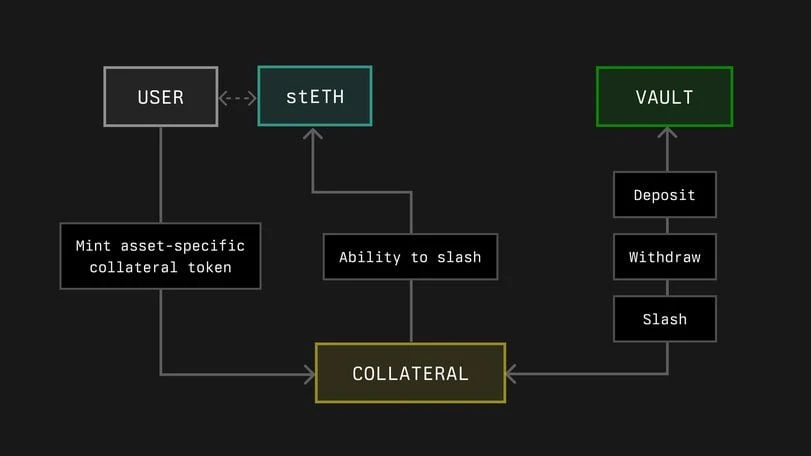Original article by Sam Kessler , CoinDesk
Original translation: Felix, PANews
Key points:
The co-founders of dominant liquidity staking protocol Lido and venture capital firm Paradigm are secretly funding a new company called Symbiotic that will compete in the fast-growing “re-staking” space, according to people familiar with the matter.
The emergence of a re-staking project with strong financial support may herald the beginning of a game that redefines the DeFi landscape.
The co-founder of Lido, the largest liquidity pledge protocol on Ethereum, is secretly funding a competitor to EigenLayer. As a popular re-pledge protocol, EigenLayer has rapidly emerged this year and has become a strong force in DeFi.
The project, called Symbiotic, is backed not only by Lido co-founders Konstantin Lomashuk and Vasiliy Shapovalov through venture capital firm Cyber Fund, but also by Paradigm, one of Lido’s main investors, according to several people familiar with the matter.
Internal Symbiotic documents obtained by CoinDesk show that the project allows users to re-stake with Lidos stETH and other popular assets that are not natively compatible with EigenLayer. Developed by the team that previously created the Stakemind staking service, Symbiotic will be a permissionless re-staking protocol that provides a flexible mechanism for decentralized networks to coordinate node operators and economic security providers.
The documents are marked as “preliminary” and “not for public disclosure,” but several teams building in the nascent re-staking ecosystem say they are already discussing integration with Symbiotic (including active verification services and liquidity re-staking services based on EigenLayer).
New Kids in Town
Lido made a splash in the DeFi space a few years ago when it developed a protocol that allowed users to stake cryptocurrencies on Ethereum (essentially locking them up) but still receive a token called “stETH” for trading. The project has proven so popular that it is now the largest DeFi protocol on Ethereum, with $27 billion worth of deposits. It has gained such an important position that some participants are concerned about the operational risks posed by Lido’s super influence.
But recently, Lido has been struggling with a decline in market share as users have moved their assets to EigenLayer, which allows users to re-stake Ethereum’s native token, ETH, to help secure other networks. EigenLayer is one of the most successful projects in the crypto space in recent years, attracting about $16 billion in deposits since it opened to investors last year.
Similar to EigenLayer, Symbiotic will provide a scheme called Active Validation Services (AVS) for decentralized applications to collectively ensure each others security. Users will be able to re-stake their assets stored in other crypto protocols to help secure these AVSs (whether Rollups, interoperability infrastructure, or oracles) in exchange for rewards.
The key difference between Symbiotic and EigenLayer is that users can directly deposit any asset based on the Ethereum ERC-20 token standard into Symbiotic, which means that the protocol will be directly compatible with stETH, as well as thousands of other assets based on the ERC-20 standard. EigenLayer only accepts ETH tokens.
A screenshot of an internal Symbiotic document obtained by CoinDesk describing the protocol’s “five interrelated components.”
Ironically, when venture capital giant Paradigm approached EigenLayer co-founder Sreeram Kannan to invest in his project, he turned down their money in favor of a16z, according to several people familiar with the matter. Paradigm told Sreeram Kannan that they would invest in EigenLayers competitors.
The track is large enough to accommodate multiple companies
The emergence of a potentially strong competitor to EigenLayer highlights how eager institutions and investors are to get involved in the re-staking space as it becomes a hot topic in the industry. Blockworks reported in April that another re-staking startup, Karak, had received funding from Coinbase and others.
“This track is big enough for more than one big company,” said one infrastructure operator that intends to integrate with Symbiotic, but requested anonymity because the project is still secretive. “I think Uber and Lyft are the best examples, and here too, the re-staking market will be huge.”
The involvement of Cyber Fund, led by Lido’s co-founder, and Paradigm could put Symbiotic in a strong position to challenge EigenLayer. It is also further evidence that people close to Lido see EigenLayer as a potential threat to Lido’s dominance.
While Lido remains the largest DeFi protocol on Ethereum, the project’s strategy around re-staking may determine whether (and how) it can maintain its leading position in the staking space.
Liquidity re-staking companies that deposit user funds into EigenLayer have cannibalized Lido’s stETH market. The two largest liquidity re-staking protocols, Ether.Fi and Renzo, have seen net inflows of $625 million over the past 30 days. Meanwhile, Lido has seen net outflows of $75 million over the same period.
This week, members of the Lido DAO (the governance body that controls the Lido protocol) publicly proposed the Lido Alliance, a guiding framework for thinking about restaking. The proposal states: The Lido DAO will identify and recognize projects that share the same values and mission and can make positive contributions to the stETH ecosystem. Developing an ecosystem around stETH that is consistent with Ethereum will help decentralize the network.
While Lido is not directly affiliated with Symbiotic, the restaking company funded by Lido’s co-founder fits in nicely with the Lido Alliance framework. EigenLayer only accepts ETH deposits, while Symbiotic doesn’t accept ETH deposits at all. Instead, Symbiotic will allow users to directly deposit any ERC-20 token, such as Lido’s stETH.
Symbiotic’s project document shows: “Collateral in Symbiotic can include ERC-20 tokens, withdrawal receipts from Ethereum validators, or other on-chain assets (such as LP positions), but there is no restriction on the blockchain where the position is held.”
Discussion on the re-pledge project

A screenshot of an internal Symbiotic document obtained by CoinDesk is titled: “Example of collateral using ERC 20 tokens. When users deposit into a vault, the creation of collateral will be abstracted.”
Symbiotic’s approach to collateral ties into its ambition to be a “permissionless” protocol, meaning that applications built on the platform should have a lot of leeway in deciding how to extend the platform to serve their own use cases.
“I’m excited about what they’re doing. It seems interesting and innovative,” Ether.Fi co-founder Mike Silgadze said in a Telegram message. “They seem very focused on building something completely permissionless and decentralized.”
Another liquidity re-staking protocol, Renzo, is already in discussions to integrate with Symbiotic after its launch, according to people familiar with the matter.
Symbiotic has not released any information publicly or confirmed when it plans to launch, but four sources consulted for this article said they expect the platform to be released in some form by the end of this year.










